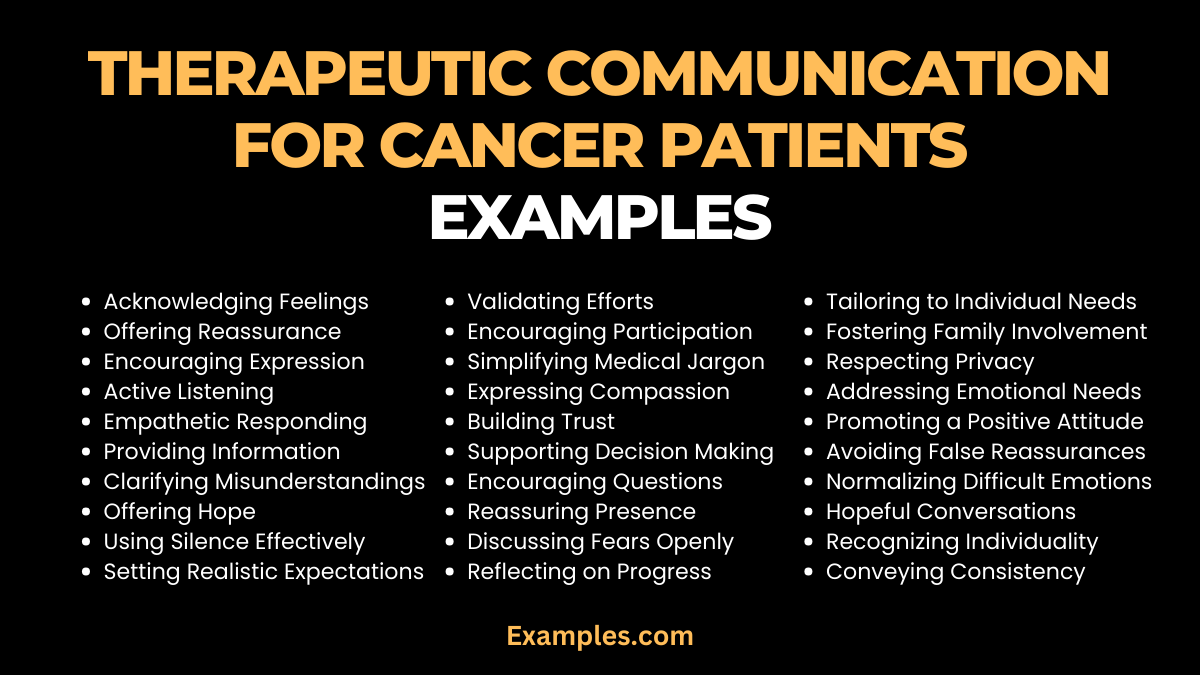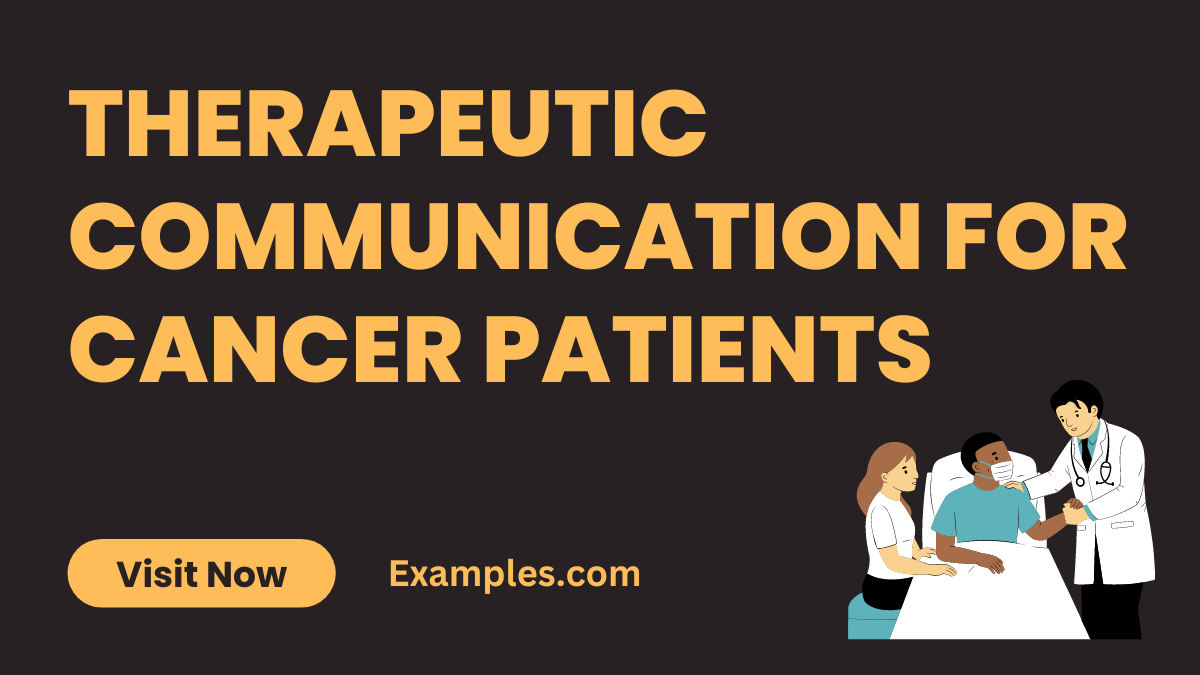29+ Therapeutic Communication for Cancer Patients Examples
Therapeutic Communication for Cancer Patients is a comprehensive guide designed to help healthcare professionals enhance their communication skills with individuals battling cancer. This guide includes practical examples and strategies, focusing on fostering empathy, understanding, and emotional support in interactions. It emphasizes the use of therapeutic dialogue techniques, such as active listening and empathetic responding, to create a supportive environment for cancer patients. This resource is invaluable for those seeking to improve their communication skills in oncology settings, ensuring every conversation contributes positively to the patient’s emotional well-being and treatment journey.
What is Therapeutic Communication for Cancer Patients?
Therapeutic communication for cancer patients refers to specialized interpersonal interactions designed to comfort, support, and empower individuals battling cancer. This form of communication involves empathy, active listening, and providing emotional support. It’s crucial for establishing trust and facilitating effective coping strategies. Key aspects include acknowledging the patient’s fears and concerns, offering hope and reassurance, and ensuring clear and compassionate dialogue. This approach aids in reducing anxiety and promoting a positive outlook, which can be pivotal in the healing journey of cancer patients.
30 Therapeutic Communication for Cancer Patients Examples

Therapeutic communication is essential in cancer care, offering patients comfort and understanding. This guide offers 30 examples, showcasing the best practices for effectively communicating with cancer patients.
- Acknowledging Feelings: “I can see this is really tough for you.” Acknowledging a patient’s emotions validates their experience.
- Offering Reassurance: “We’re here to support you through this journey.” This conveys a sense of team support.
- Encouraging Expression: “Tell me more about what you’re feeling right now.” Invites patients to share their thoughts and feelings.
- Active Listening: “I understand that you’re feeling anxious about the treatment.” Reflects and validates patient concerns.
- Empathetic Responding: “It’s completely normal to feel scared in this situation.” Shows understanding and empathy.
- Providing Information: “Let me explain what the treatment involves.” Offering clear, concise information can reduce anxiety.
- Clarifying Misunderstandings: “What aspect of the treatment concerns you the most?” Helps address specific patient worries.
- Offering Hope: “Many patients find strength they didn’t know they had during treatment.” Instills a sense of hope and resilience.
- Using Silence Effectively: Allowing moments of silence gives patients time to process and express thoughts.
- Setting Realistic Expectations: “While we can’t predict outcomes, we’re committed to providing the best care possible.” Balances hope with realism.
- Validating Efforts: “You’re doing an incredible job managing these challenges.” Recognizes and validates the patient’s efforts and strength.
- Encouraging Participation in Care: “What are your thoughts on the proposed treatment plan?” Involves patients in their care decisions.
- Simplifying Medical Jargon: “Let me put this in simpler terms.” Ensures understanding by avoiding complex medical language.
- Expressing Compassion: “I’m truly sorry you’re going through this.” Demonstrates genuine care and compassion.
- Building Trust: “You can talk to me about anything you’re feeling.” Fosters a trusting relationship.
- Supporting Decision Making: “What’s most important to you in your treatment?” Supports patient autonomy.
- Encouraging Questions: “Do you have any questions or concerns?” Promotes open communication.
- Reassuring Presence: “I’m here with you.” Offers comfort through presence.
- Discussing Fears Openly: “It’s okay to talk about your fears.” Creates a safe space for expressing fears.
- Reflecting on Progress: “Let’s look at how far you’ve come.” Highlights positive progress and milestones.
- Tailoring Communication to Individual Needs: Adjusts communication style based on patient’s preferences and needs.
- Fostering Family Involvement: “Would you like your family involved in this discussion?” Encourages family support.
- Respecting Privacy and Dignity: Ensures conversations are held in private, respecting the patient’s dignity.
- Addressing Emotional Needs: “How are you coping emotionally?” Addresses the psychological impact of cancer.
- Promoting a Positive Attitude: “Your attitude can make a big difference in your journey.” Encourages positivity without dismissing concerns.
- Avoiding False Reassurances: “I wish I could give guarantees, but I promise to be here for you.” Avoids making unrealistic promises.
- Normalizing Difficult Emotions: “Many people in your situation feel this way.” Normalizes feelings of fear and uncertainty.
- Facilitating Hopeful Conversations: “Let’s talk about your hopes and goals.” Shifts focus to positive future aspirations.
- Recognizing Individuality: “You’re more than your cancer diagnosis.” Acknowledges the person beyond their illness.
- Conveying Consistency and Reliability: “You can count on me to be here for you.” Shows commitment and reliability in care.
What are the Therapeutic Communication Techniques for Cancer Patients?

Therapeutic communication techniques for cancer patients involve strategies that are aimed at providing emotional support and understanding. These techniques include active listening, showing empathy, encouraging patients to share their feelings, offering reassurance, explaining medical information clearly, acknowledging and validating emotions, using humor appropriately, and respecting the patient’s privacy and dignity. Each of these methods helps in creating a supportive environment that can significantly aid in the emotional well-being of cancer patients.
- Active Listening: Prioritizing attentive, empathetic listening to understand the patient’s emotional and physical needs.
- Empathy Expression: Conveying empathy and compassion, showing understanding of the patient’s experiences and emotions.
- Encouraging Dialogue: Prompting patients to express their feelings and fears about their condition and treatment.
- Offering Reassurance: Providing comforting words and gestures that offer hope and reassurance to alleviate anxiety.
- Providing Information: Clearly and sensitively explaining medical procedures and treatment plans to reduce uncertainty.
- Acknowledging Emotions: Recognizing and validating the patient’s feelings, affirming that their emotional responses are normal and understandable.
- Using Humor Appropriately: Employing humor when appropriate to lighten the mood and foster a positive patient-caregiver relationship.
- Maintaining Privacy and Respect: Respecting the patient’s privacy and dignity at all times, ensuring a safe and comfortable environment for communication.
These techniques, centered on emotional support and effective communication, are crucial in enhancing the well-being and outlook of cancer patients.
What are the Therapeutic Activities for Cancer Patients?
Therapeutic activities for cancer patients encompass a range of practices aimed at enhancing their physical, emotional, and mental well-being. These activities include art and music therapy, which allow for creative expression and emotional release. Exercise, including gentle activities like walking or yoga, helps maintain physical strength. Meditation and mindfulness techniques are used for relaxation and stress management. Support groups offer emotional support and community. Pet therapy provides comfort through animal interactions. Nutritional counseling ensures a healthy diet to support treatment, and massage therapy offers physical relief and relaxation. Each activity plays a vital role in supporting the overall health and resilience of cancer patients.
- Art Therapy: Art therapy allows patients to express emotions through creative activities like painting and sculpting, aiding in emotional healing.
- Music Therapy: Music therapy involves listening to or creating music, helping to reduce stress and improve mood.
- Exercise: Light exercise, like walking or yoga, can boost physical strength and mental well-being.
- Meditation and Mindfulness: These practices promote relaxation and help in managing anxiety and emotional stress.
- Support Groups: Joining support groups provides social support and a platform to share experiences with others facing similar challenges.
- Pet Therapy: Interacting with animals can offer comfort and a sense of calm.
- Nutritional Counseling: Proper nutrition is vital for cancer patients, helping them maintain strength and health during treatment.
- Massage Therapy: Massage therapy can reduce pain and discomfort, offering a sense of physical and emotional relief.
How Does Therapeutic Communication Help Cancer Patients?
Therapeutic communication helps cancer patients by providing emotional support and a safe environment for expressing their fears and concerns. This type of communication enhances the patient-doctor relationship, fostering trust and personalized care. It plays a crucial role in reducing anxiety and stress, aiding patients in coping with their diagnosis and treatment. Furthermore, clear and empathetic dialogue assists patients in understanding their treatment options, which is essential for informed decision-making and improving compliance with treatment plans. This communication approach ultimately contributes to better treatment outcomes and overall well-being.
1. Providing Emotional Support:
Therapeutic communication offers a safe space for cancer patients to express their feelings, helping to alleviate emotional burden.
2. Enhancing Patient-Doctor Relationships:
Effective communication builds trust between patients and healthcare providers, leading to more personalized care.
3. Reducing Anxiety and Stress:
Open and empathetic conversations can significantly reduce feelings of anxiety and stress in patients.
4. Aiding in Treatment Decision-Making:
Clear communication helps patients understand their treatment options, empowering them to make informed decisions.
5. Improving Coping Mechanisms:
Discussing fears and concerns allows healthcare professionals to guide patients towards effective coping strategies.
6. Boosting Treatment Compliance:
Understanding the importance of treatment through empathetic communication can lead to increased patient compliance and positive outcomes.
It emphasizes the importance of empathy, understanding, and emotional support in interactions with cancer patients. The guide covers various aspects of therapeutic communication, including active listening, empathetic responding, and creating a supportive environment. It is a valuable resource for those looking to enhance their communication skills in oncology settings.
To conclude, therapeutic communication is an integral part of cancer care. It involves more than just medical treatment; it’s about connecting with patients on a human level, understanding their fears, and offering comfort. For additional resources on communication in healthcare, the National Cancer Institute offers valuable insights and guidelines. Additionally, for a deeper understanding of patient-centered care, The Institute for Healthcare Communication provides extensive information and training resources. These resources can further assist healthcare professionals in honing their skills to provide compassionate and effective care to cancer patients.



